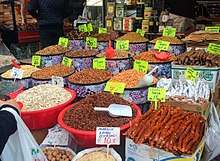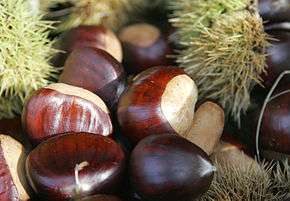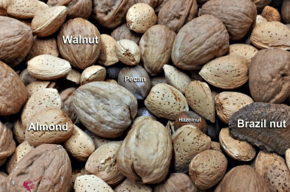Nut (fruit)
A nut is a fruit composed of an inedible hard shell and a seed, which is generally edible. In general usage, a wide variety of dried seeds are called nuts, but in a botanical context "nut" implies that the shell does not open to release the seed (indehiscent). The translation of "nut" in certain languages frequently requires paraphrases, as the word is ambiguous.


Most seeds come from fruits that naturally free themselves from the shell, unlike nuts such as hazelnuts, chestnuts, and acorns, which have hard shell walls and originate from a compound ovary. The general and original usage of the term is less restrictive, and many nuts (in the culinary sense), such as almonds, pecans, pistachios, walnuts, and Brazil nuts,[1] are not nuts in a botanical sense. Common usage of the term often refers to any hard-walled, edible kernel as a nut.[2] Nuts are an energy-dense and nutrient-rich food source.[3]
Botanical definition
A nut in botany is a simple dry fruit in which the ovary wall becomes increasingly hard as it matures, and where the seed remains unattached or free within the ovary wall. Most nuts come from the pistils with inferior ovaries (see flower) and all are indehiscent (not opening at maturity). True nuts are produced, for example, by some plant families of the order Fagales.
- Order Fagales (not all species produce true nuts)
- Family Fagaceae
- Family Betulaceae
A small nut may be called a "nutlet" (or nucule, a term otherwise referring to the oogonium of stoneworts). In botany, the term "nutlet" specifically refers to a pyrena or pyrene, which is a seed covered by a stony layer, such as the kernel of a drupe. Walnuts and hickories (Juglandaceae) have fruits that are difficult to classify. They are considered to be nuts under some definitions but are also referred to as drupaceous nuts. "Tryma" is a specialized term for hickory fruits.
In common use, a "tree nut" is, as the name implies, any nut coming from a tree. This most often comes up regarding food allergies, a person may be allergic specifically to peanuts (which are not tree nuts but legumes), whereas others may be allergic to the wider range of nuts that grow in trees.
Culinary definition and uses
See also
- List of culinary nuts
- List of edible seeds
- List of foods
- Nutmeg
- Achene
References
Notes
- Alasalvar, Cesarettin; Shahidi, Fereidoon. Tree Nuts: Composition, Phytochemicals, and Health Effects (Nutraceutical Science and Technology). CRC. p. 143. ISBN 978-0-8493-3735-2.
- Black, Michael H.; Halmer, Peter (2006). The encyclopedia of seeds: science, technology and uses. Wallingford, UK: CABI. p. 228. ISBN 978-0-85199-723-0.
- "Nuts". Micronutrient Information Center, Linus Pauling Institute, Oregon State University, Corvallis, OR. 1 September 2018. Retrieved 28 March 2019.
Further reading
- Albala, Ken (2014) Nuts A Global History. The Edible Series. ISBN 978-1-78023-282-9
External links
| Wikimedia Commons has media related to Nuts. |
| Wikiquote has quotations related to: Nut (fruit) |

